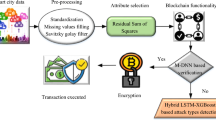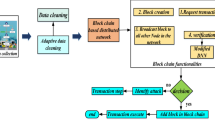Abstract
Internet of Things (IoT) usage is cherishing nowadays and it is widely used in variety of exciting application such as hospital, industry and cities. Security is found to be a major concern in IoT based application due to advancement made in the field of Information and software technology. Transactions using internet has become significantly in case of smart cities and it is frequently prone to various cyber security threats. For securing various transaction in smart cities hybrid deep learning LSTM-SVM algorithm is developed. Initially, data related to transaction in smart cities is gathered and pre-processed utilizing min-max normalization and weighted average filter. Min-max normalization is employed or normalizing the raw data to a certain range. Then, weighted average filter is used for removing noise in the data. After that, appropriate features from pre-processed data is selected using reptile search algorithm. Using industrial gateway, the selected features are provided to blockchain based distributed network. Function of blockchain is to verify the transaction process using trusted entities. Verifier check whether the transaction is genuine or fake through detecting the presence of attack. In case of genuine transaction request, the transaction is accomplished through creating a block on the blockchain. On the other hand, if an attack is detected the transaction is blocked and further types of attack is predicted using deep learning-based hybrid LSTM- SVM classifier. Simulation analysis on the proposed hybrid deep learning model showed 97% accuracy, 98% specificity, 91% F1 score and 82% sensitivity. Based on this proposed model fake transaction in IoT based blockchain is blocked and paved way for development of secure smart cities environment.





























Similar content being viewed by others
Data availability
Not applicable.
Code availability
Not applicable.
References
Karthick S, Perumal Sankar S, Arul Teen YP (2021) Trust-Distrust Protocol for Secure Routing in Self-Organizing Networks. In 2018 International Conference on Emerging Trends and Innovations In Engineering And Technological Research (ICETIETR), pp 1-8. https://doi.org/10.1109/ICETIETR.2018.8529016
Abd El-Latif AA, Abd-El-Atty B, Mehmood I, Muhammad K, Venegas-Andraca SE, Peng J (2021) Quantum-inspired blockchain-based cybersecurity: securing smart edge utilities in IoT-based smart cities. Inf Process Manag 58(4):102549
Abualigah L, Abd Elaziz M, Sumari P, Geem ZW, Gandomi AH (2022) Reptile search algorithm (RSA): a nature-inspired meta-heuristic optimizer. Expert Syst Appl 191:116158
Ahlawat S, Choudhary A (2020) Hybrid CNN-SVM classifier for handwritten digit recognition. Proc Comput Sci 167:2554–2560
Alasbali N, Azzuhri SR, Salleh R (2020) A blockchain-based smart network for IoT-driven smart cities. In: Proceedings of the 2020 2nd international electronics communication conference, pp 17–23
Bacanin N, Stoean R, Zivkovic M, Petrovic A, Rashid TA, Bezdan T (2021) Performance of a novel chaotic firefly algorithm with enhanced exploration for tackling global optimization problems: application for dropout regularization. Mathematics 9(21):2705
Bacanin N, Budimirovic N, Strumberger I, Alrasheedi AF, Abouhawwash M (2022) Novel chaotic oppositional fruit fly optimization algorithm for feature selection applied on COVID 19 patients’ health prediction. PLoS One 17(10):e0275727
Botello JV, Mesa AP, Rodríguez FA, Díaz-López D, Nespoli P, Mármol FG (2020) BlockSIEM: protecting smart city services through a blockchain-based and distributed SIEM. Sensors 20:4636
El Majdoubi D, El Bakkali H, Sadki S (2020) Towards smart blockchain-based system for privacy and security in a smart city environment. In: 2020 5th international conference on cloud computing and artificial intelligence: technologies and applications (CloudTech). IEEE, pp 1–7
Elsaeidy AA, Jagannath N, Sanchis AG, Jamalipour A, Munasinghe KS (2020) Replay attack detection in smart cities using deep learning. IEEE Access 8:137825–137837
Esposito C, Ficco M, Gupta BB (2021) Blockchain-based authentication and authorization for smart city applications. Inf Process Manag 58:102468
Fang S, Chen Y, Lin H (2020) A self-adaptive control for phase-controlled electromagnetic contactor using weighted moving average filter. IEEE Trans Ind Electron 68:8963–8972
Gong S, Tcydenova E, Jo J, Lee Y, Park JH (2019) Blockchain-based secure device management framework for an internet of things network in a smart city. Sustainability 11:3889
Hakak S, Khan WZ, Gilkar GA, Imran M, Guizani N (2020) Securing smart cities through blockchain technology: architecture, requirements, and challenges. IEEE Netw 34:8–14
Islam MJ, Rahman A, Kabir S, Karim MR, Acharjee UK, Nasir MK, Wu S (2021) Blockchain-SDN-based energy-aware and distributed secure architecture for IoT in smart cities. IEEE Internet Things J 9:3850–3864
Keshk M, Turnbull B, Moustafa N, Vatsalan D, Choo KKR (2019) A privacy-preserving-framework-based blockchain and deep learning for protecting smart power networks. IEEE Trans Ind Inf 16(8):5110–5118
Kim HJ, Baek JW, Chung K (2021) Associative knowledge graph using fuzzy clustering and min-max normalization in video contents. IEEE Access 9:74802–74816
Kumar P, Kumar R, Srivastava G, Gupta GP, Tripathi R, Gadekallu TR, **ong NN (2021) PPSF: a privacy-preserving and secure framework using blockchain-based machine-learning for IoT-driven smart cities. IEEE Tran Netw Sci Eng 8:2326–2341
Kumar P, Gupta GP, Tripathi R (2021) TP2SF: a trustworthy privacy-preserving secured framework for sustainable smart cities by leveraging blockchain and machine learning. J Syst Archit 115:101954
Kumar PM, Rawal B, Gao J (2022) Blockchain-enabled privacy preserving of IoT data for sustainable smart cities using machine learning. In: 2022 14th international conference on COMmunication systems & NETworkS (COMSNETS). IEEE, pp 1–6
Majeed U, Khan LU, Yaqoob I, Kazmi SA, Salah K, Hong CS (2021) Blockchain for IoT-based smart cities: recent advances, requirements and future challenges. J Netw Comput Appl 181:103007
Malakar S, Ghosh M, Bhowmik S, Sarkar R, Nasipuri M (2020) A GA based hierarchical feature selection approach for handwritten word recognition. Neural Comput & Applic 32:2533–2552
Rao G, Huang W, Feng Z, Cong Q (2018) LSTM with sentence representations for document-level sentiment classification. Neurocomputing 308:49–57
Rathore S, Kwon BW, Park JH (2019) BlockSecIoTNet Blockchain-based decentralized security architecture for IoT network. J Netw Comput Appl 143:167–177
Salim MM, Shanmuganathan V, Loia V, Park JH (2021) Deep learning enabled secure IoT handover authentication for blockchain networks. Hum Cent Comput Inf Sci 11:21
Serrano W (2021) The blockchain random neural network for cybersecure IoT and 5G infrastructure in smart cities. J Netw Comput Appl 175:102909
Singh SK, Jeong YS, Park JH (2020) A deep learning-based IoT-oriented infrastructure for secure smart city. Sustain Cities Soc 60:102252
Singh SK, Azzaoui AE, Kim TW, Pan Y, Park JH (2021) DeepBlockScheme: a deep learning-based blockchain driven scheme for secure smart city. Hum-Centric Comput Inf Sci 11:12
UNSW_NB15: https://www.kaggle.com/datasets/mrwellsdavid/unsw-nb15?select=UNSW-NB15_2.csv. Accessed 15 July 2022
Vargas H, Lozano-Garzon C, Montoya GA, Donoso Y (2021) Detection of security attacks in industrial IoT networks: a blockchain and machine learning approach. Electronics 10:2662
Karthick S (2018) TDP: A Novel Secure and Energy Aware Routing Protocol for Wireless Sensor Networks. International Journal of Intelligent Engineering and Systems 11(2):76-84. https://doi.org/10.22266/ijies2018.0430.09
Author information
Authors and Affiliations
Contributions
The corresponding author claims the major contribution of the paper including formulation, analysis and editing. The co-authors provide guidance to verify the analysis result and manuscript editing.
Corresponding author
Ethics declarations
This article is a completely original work of its authors; it has not been published before and will not be sent to other publications until the journal’s editorial board decides not to accept it for publication.
Conflict of interest
The authors declared that they have no conflicts of interest to this work. We declare that we do not have any commercial or associative interest that represents a conflict of interest in connection with the work submitted.
Additional information
Publisher’s note
Springer Nature remains neutral with regard to jurisdictional claims in published maps and institutional affiliations.
Rights and permissions
Springer Nature or its licensor (e.g. a society or other partner) holds exclusive rights to this article under a publishing agreement with the author(s) or other rightsholder(s); author self-archiving of the accepted manuscript version of this article is solely governed by the terms of such publishing agreement and applicable law.
About this article
Cite this article
Mishra, S., Chaurasiya, V.K. Hybrid deep learning algorithm for smart cities security enhancement through blockchain and internet of things. Multimed Tools Appl 83, 22609–22637 (2024). https://doi.org/10.1007/s11042-023-16406-6
Received:
Revised:
Accepted:
Published:
Issue Date:
DOI: https://doi.org/10.1007/s11042-023-16406-6




